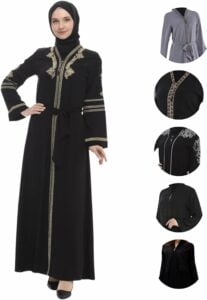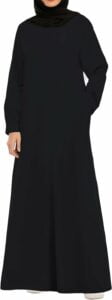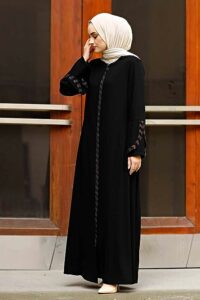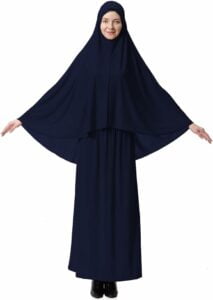What is an abaya dress?
It generally means Khimar and Jilbab as long as it fulfills the basic requirements of khimar and jilbab.
What is an abaya? The practice of wearing the abaya or hijab has existed since Prophet Muhammad (ﷺ). Nearly 1440 years have passed, and still, this practice is becoming widespread. We’ve seen many stories in the news about Muslim women facing tough times worldwide. Some people say it’s because of Muslim men who are called “oppressive” and linked to their religion and societies, but this might not always be fair or accurate.
Though some of the stories are true, most are made up to highlight and keep spreading certain unfair beliefs about Muslims.
In the Quran, Allah emphasizes the equality of all human beings. In Al-Hujurat (Chapter 49), verse 13, it is stated:
Islam is a religion that believes in Allah’s oneness and his commands revealed in the Quran by Prophet Muhammad (ﷺ). The holy Quran is the only book that has not been changed or modified if you compare it with all the other religious texts.
In the Quran, Allah says in Al-Hujurat (Chapter 49), verse 13:
‘We’ve created people from both men and women, and we made different groups and tribes so you all can learn from each other. The most honorable person in the eyes of Allah is the one who is the most good and fair. Allah knows everything about us.’
This verse highlights the importance of equality and righteousness in the eyes of Allah, regardless of one’s background or ethnicity.
- What is an abaya dress?
- Is it haram to wear color abaya?
- What is an Abaya: A Symbol of Modesty and Individual Style
- Which countries abaya is compulsory?
- Do you have to pray in abaya?
- At what age does a girl start wearing hijab?
- What is the difference between abaya and burqa?
- Can foreigners wear abaya?
- Is abaya compulsory in Islam?
- Where to buy abaya online?
- Do you wear anything under abaya?
- Can I wear abaya to an Interview?
- Conclusion.
Is it haram to wear color abaya?
It is permissible to wear any color Abaya until and unless that Abaya she wore is to show off her beauty to other non-mahram men (Strangers or unrelated individuals). The Abaya can be of any color but should not attract men’s gaze, which means overly decorative in line with the verse (interpretation): “…and not to show off their ornament.” [al-Nur 24:31].
This guidance extends to outer garments if they are ornate. Abu Dawud (565) reports from Abu Hurayrah that the Prophet Muhammad (ﷺ) said: “Do not stop the female slaves of Allah from attending the mosques of Allah SWT but let them go out unadorned.” (Authenticated by al-Albani in Irwa al-Ghalil, 515).
‘Awn al-Ma’bud clarifies that “unadorned” means not wearing perfume, and women are instructed to go out in this manner to avoid arousing men’s desires with their fragrance. This also encompasses other prohibited things, such as attractive clothing and noticeable expensive embellishments, due to their potential to incite lust.
What is an Abaya: A Symbol of Modesty and Individual Style
In Surah Al-Ahzab, chapter 33rd in the holy Quran and verse 33:59, it discusses modesty in Islam and how Muslim women can protect themselves from harassment and molestation.
“This is a better way for people to know that they are Muslim women and to stay safe from any bad treatment or harm.” source (Al-Islam.org)
Men often find themselves subject to their lust and cravings, whether they openly admit it or not.
The abaya in Islam protects our beautiful Muslim women from such men, and it states that she has been sanctified to one man only, and it is haram for her to look for other men.
Benefits of wearing a abaya in Islam for both women and society:
Spiritual fulfillment: Hijab is an act of obedience towards Allah and his commandments.
Modesty: The Hijab promotes humility, and Muslim women can avoid unwanted attention and promote dignity.
Protection: wearing modest clothing reduces the risk of being harassed or catcalling.
Inner beauty: wearing a Hijab encourages society to see women’s inner beauty and their skills.
One of the significant events in the early history of Islam was the Karbala event. It was a kind of protest led by Imam Husayn (عليها السلام) against a ruler named Yazid, who was unfair. In this protest, Yazid’s soldiers did a horrible thing—martyred Imam Husayn (عليها السلام) and about seventy-two people with him.
But even after this sad event, Imam Husayn’s sister, Zaynab (عليها السلام), didn’t give up. She continued to protest and was very good at convincing people to stand up against evil rulers. Zaynab (عليها السلام) played a significant role in making things more challenging for the rulers, and eventually, they lost their power. So, Zaynab (عليها السلام) was a hero who helped bring down the rulers who were being mean to the people.
“Modesty adorns everything, and its absence leaves everything ugly.”
Imam ali (عليها السلام)
Which countries abaya is compulsory?
The list of countries where Abaya is compulsory are:
| Country | Abaya/Hijab Requirement |
|---|---|
| Saudi Arabia | Compulsory for women in public. |
| Iran | Compulsory for women in public. |
| Afghanistan | Compulsory under Taliban rule. |
| Sudan | Compulsory under certain circumstances. |
| Yemen | Strongly encouraged for women in public. |
| Qatar | Encouraged for women in public. |
| United Arab Emirates | Encouraged for women in public. |
| Oman | Encouraged for women in public. |
| Kuwait | Encouraged for women in public. |
| Bahrain | Encouraged for women in public. |
| Pakistan | Strongly encouraged in some areas. |
| Malaysia | Encouraged for Muslim women. |
| Brunei | Encouraged for Muslim women. |
Do you have to pray in abaya?
A woman’s prayer is accepted when she prays in a jilbab (a one-piece garment that covers her entire body) or without a jilbab. Still, in that case, she must wear loose-fitting, non-transparent izaar, kamees, and a headscarf, ensuring they cover her awrah completely.
The word “jilbab” is used in the Quran to describe ‘shawls.’ It refers to a long sheet of cloth that covers a woman from head to foot. This information comes from Sayyidna Abdullah ibn Abbas, as mentioned in Ma’ariful Quran on page 222, volume 7.
In Islamic teachings, the entire body of a free woman is considered her awrah, which is the part that must be covered. However, there is an exception for her face and the palms of her two hands. This teaching is based on the words of the Prophet (ﷺ), as narrated by Tirmizi 1173, and can be found in Hidayah on page 92, volume 1.
“For the prayer to be correct, it is not a condition to wear a specific clothing, but in fact, one’s prayer is complete with clothing that covers the awrah.” (Fatawa Uthmaani p.373 v.1)
It is a good practice for women to wear three types of clothing for Salah:
- Izaar, such as trousers or lower garments.
- Kamees, an upper apparel or dress.
- Headscarf, a garment that covers her entire head and shoulders. (Umdatul Fiqh p.61v.2)
Now, to answer your question: If a woman prays Salah in clothing that doesn’t cover her awrah (from head to feet), her Salah would not be considered valid.
At what age does a girl start wearing hijab?
The age when a girl is required to wear the Hijab is when she reaches puberty. Puberty is often recognized by the beginning of menstruation, but the timing of this milestone can differ from one person to another. The Quran does not specify at what age girl should start wearing the Hijab, but it emphasizes being modest in their clothing and behavior.
Sign of puberty for females in Islam:
For females, the sign of puberty is generally:
- Menstruation
If the girl reaches the age of puberty, she is obliged to follow Islamic principles such as wearing an abaya in Islam.
In Islam, a person is not held accountable for their actions until they reach the age of puberty. Before reaching puberty, they are not considered liable. This teaching is based on a saying of the Prophet Muhammad (ﷺ), who stated:
- Children: Kids who haven’t reached the age of puberty are not responsible for their deeds in the eyes of Islam. They are considered innocent and not judged for what they do.
- Sleepers: When someone is asleep, they also are not accountable for anything they might say or do during that time. It’s because they are not fully conscious of their actions while asleep.
- People with mental illness: Those who have lost their mental faculties due to illness or other reasons are also exempt from moral and religious responsibility. They are not judged for their actions until they recover and are of sound mind again.
This saying is narrated by Abu Dawud (Sunan an-Nasa’i 3432).
What is the difference between abaya and burqa?
In the world of Islamic clothing, there are various styles and choices that Muslim women may opt for, following their cultural backgrounds while still adhering to the Qur’anic guidelines. This diversity in implementing the same Qur’anic law reflects the global nature of Islam, which transcends regional, tribal, and cultural boundaries.
For instance, in Arabia, Muslim women often wear the ‘abaya. In Persia, the chador is a common choice, while the burqa is prevalent in Afghanistan. Indo-Pakistani Muslim women often opt for the niqab or purdah, while those in Malaysia and Indonesia wear the kerudung. East African Muslim women commonly wear the buibui. In Western countries like Canada, Muslim women sometimes wear mainstream clothing with a more oversized scarf covering their head and a loose-fitting outfit.
It’s important to note that Islam does not prescribe a specific style but emphasizes the essential requirements of khimar and jilbab, which involve covering particular body parts. The various clothing styles mentioned earlier represent the intersection of religion and culture. Some individuals, however, mistakenly view the hijab as a mere cultural tradition rather than a religious obligation.
Can foreigners wear abaya?
Yes, non-Muslims or foreigners have no restrictions that stop them from wearing abaya in Islam. Any woman can wear an abaya dress. As per the rules, women don’t need to wear an Abaya in Islam and go out if they are in Saudi Arabia. Instead, if she is wearing modest clothing that decently covers her body, it in no way attracts the gaze of men, then she is good to go. Every other Islamic country has its own rules concerning the Abaya in Islam.
Is abaya compulsory in Islam?
Yes, an Abaya dress is a long sheet of clothing that women in Saudi Arabia wear, which helps them cover their bodies except for their faces and palms. In Islam, it is compulsory for every woman who has reached the age of puberty to cover their body when going out or in front of non-mahram Muslims. To cover their awrah, women can wear an Abaya dress or a Hijab, etc. Every country has a different culture and different hijab styles.
Where to buy abaya online?
Of course, you can buy an Abaya dress online, and I will help you get the best abaya in Islam that perfectly meets Islamic requirements. Depending upon your country, such as the United States, United Kingdom, Australia, Canada, or Europe. Below, I have shortlisted several Abaya dresses that can be purchased online. Click on the link below and help yourself out.
Abaya for women:
Affiliate Disclosure
Some links on salatllayl.com are affiliates. Clicking these may earn us a small commission without costing you extra. We only recommend what we genuinely believe in. Your support keeps us going. Feel free to ask any questions. Happy exploring!
Do you wear anything under abaya?
It is allowed to wear anything under the Abaya dress except her face and palms if it covers the woman’s body. Generally, it all depends upon the woman’s mood or the weather conditions she is in.
Under the Abaya dress, women wear clothes like any other woman would, but they ensure that their body is fully covered and no part of their body is exposed to non-mahram men.
Can I wear abaya to an Interview?
Yes, you can wear an abaya to a job interview, but it’s essential to consider adjusting to create a more business-appropriate look. Here are some tips:
- Add a blazer: Incorporating a blazer into your abaya outfit can make a significant difference. It will add a touch of formality and professionalism to your attire.
- Choose the right Abaya dress style: Opt for an A-line or more structured abaya style rather than excessively flowy ones. Flowy abayas can give off a casual or summery vibe, which may not be suitable for an interview.
- Coordinate with a printed or plain hijab: Match your hijab with your blouse or abaya, ensuring it complements your overall look.
- Avoid Excessive Accessories: Keep your accessories minimal and understated.
The main motive here is to impress Allah first because “Allah is the ultimate and best planner.” On the other hand, maintaining professionalism and a business-like manner is also essential. Trust me: you will get more than you deserve, my dear sister.
Conclusion.
Women in Islam can wear any style or color and material of the Khimar and Jilbab as long as it fulfills the basic requirements of khimar and jilbab.
For Instance, different country has different rules; in Saudi Arabia, Muslim women use the Abaya in Islam, and the Indo-Pakistani Muslim women use the niqab or purdah.
Thankyou all for reading this blog post. It means a lot. My main motive is to spread the teachings of our beloved Prophet Muhammad (ﷺ). If you like reading this article, please do share, subscribe, and comment your opinions.




